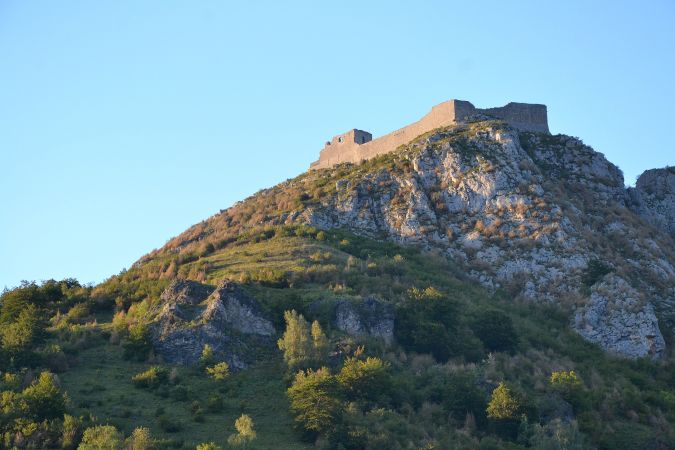The city of Carcassonne in the south of France hopes to obtain UNESCO World Heritage certification for its sentinel mountain castles, better known as Les Châteaux Cathares. Built in the 13th century, the castles are an exceptional example of the military architecture and construction of the time. The Association Mission Patrimoine Mondial (AMPM) was created to manage the process for the city. As a part of the certification process, it needed to provide 3D models that could identify known archaeological remains and possibly detect new ones for future exploration to ensure that they are all protected by the UNESCO certification. L’Avion Jaune was mandated to fly the mission using the YellowScan Explorer Lidar solution.
What Was the Challenge?
The seven fortified castles are spread out over 60 kilometres of mountainous terrain and are not easily accessible by foot, so traditional archaeological methods did not make sense for this phase of the project. A secondary objective of the project was to identify new archaeological sites that had not previously been identified and were invisible to the naked eye for further research, as well as survey the primary seven sites looking for ruins yet to be discovered.

Solution
Given the mountainous terrain and distance between the castles, which are spread over the departments of Aude and Ariège in the south of France, it was decided that a manned helicopter mission was the best solution, to capture both photogrammetry resources for the sites and point cloud data to render the 3D models. The team used the YellowScan Explorer, its first Lidar solution that can be mounted on a light manned aircraft or helicopter or any professional UAV platform. Seven castles were surveyed in three flights over five days, 200m from the ground and at a flying speed of 30–35m/s. Ground data under canopy was obtained with a point cloud density of 80 points/m².
The Explorer, like all of YellowScan’s hardware platforms, aims to provide a solution that strikes the right balance between size, range, accuracy and weight. Combined with one-year unlimited technical support and training, users can take full advantage of Explorer’s functionality and successfully complete their surveying projects.
“Due to the difficult access and the density of the vegetation around the castles to be studied, airborne Lidar was the only feasible option. The Explorer’s long-range capability and size allowed us to easily integrate the solution on the helicopter and survey the seven castles, which are geographically distant, more quickly than if we had had to do it with a drone. Given the Explorer’s five-echo capability, it can easily penetrate the vegetation to recover the ground and generate the terrain profile, allowing the production of an accurate DTM thus giving the archaeologists a new set of mapping tools for their project.” Benjamin Pradel, pilot & aerial survey project manager, L’Avion Jaune

Results
The data recovered enabled the complete 3D modelling of the seven sentinel mountain castles, and also detected possible reliefs and ruins, suggesting undiscovered human activity that will be used to guide future archaeological excavations. The mission also justified an extension of the original protection zone planned for these historic sites.
By commissioning this survey, the AMPM has improved its understanding of the historical significance of the area and increased its chances of a successful outcome to its UNESCO World Heritage application.
The Best Approach to Selecting a Lidar system for Crewed or Uncrewed Aerial Applications
The first criteria when selecting a Lidar system is the expected accuracy. Most users will not need 1cm-accuracy when creating a DTM, but probably will for surveying facades or archaeological monuments. The next criteria is the range selection of the main application: trees more than 30m high, or a 40-storey building? This will impact the flight height for the operations, and will therefore give a better idea of which system is most suitable. This is also determined by the platform that the Lidar unit will be mounted on. The best compromise between density and productivity is then found by adapting the flight plan, in terms of speed and overlap.
YellowScan Lidar systems have been used in many different scenarios, thanks to the trust that customers have placed in its products. Its systems are used in archaeology, mining, powerline management, avalanche risk detection, rural road monitoring, and many more projects.

YellowScan’s CloudStation Software for Lidar Point Cloud Processing
The CloudStation software is very intuitive and user-friendly and requires just a few clicks to generate the final point cloud. Additional modules can improve the precision of the generated point cloud, or the interpretation of the area (automated colourization without any tie points to manually select, or ground classification).
YellowScan strives to improve the use of computer resources, by optimizing the CloudStation algorithms between releases (every three weeks) to minimize the processing time.
Do you need help selecting a Lidar solution that best fits your needs? Please get in touch for a proof of concept tailored to your unique requirements.

Key Benefits of YellowScan Explorer
- YellowScan’s longest range scanner (600m)
- Single solution for multi-platform usability
- Applanix APX-20 IMU
- Can switch between 100–500 kHC PRF, depending on mounted vehicle
- 165Hz scanning frequency
About YellowScan
YellowScan designs, develops and builds Lidar solutions for professionals who require performance, robustness and accuracy. Its hardware and software solutions are easy-to-use data collection tools that come with training and support from its experts.
Founded in 2012 in the south of France, YellowScan now has sales, customer training and support representatives around the globe. Its products are used worldwide in surveying, forestry, environmental research, archaeology, industrial inspection, civil engineering, mining, and more.
YellowScan products come with embedded laser scanners, INS, GNSS receivers and onboard computing. Each system is designed to meet the highest precision and accuracy needs for 3D mapping.
The YellowScan ecosystem is based on three pillars: compact turnkey hardware with embedded batteries that are designed, built and supplied ready to operate; proprietary software – the YellowScan CloudStation – with its user-friendly and evolving interface; and committed technical experts who deliver complete training sessions to customers upon receiving their systems, as well as one-year unlimited technical support to enable customers to confidently undertake their projects, whether they are new or experienced in the field.

